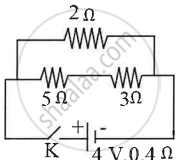Advertisements
Advertisements
Question
What happens to the resistance, as the conductor is made thicker?
Solution
The resistance of a conductor is inversely proportional to the area of cross-section of the conductors. Hence, resistance is inversely proportional to the square of the radius of the conductor.
R ∝ \(\frac{1}{A}\)
R ∝ \(\frac{1}{r^2}\)
When a conductor is made thicker, the radius will be increased and so its resistance will be decreased.
APPEARS IN
RELATED QUESTIONS
How does the resistance of a wire depend on its length? Give a reason for your answer.
Two wires of the same material and same length have radii 1 mm and 2 mm respectively. Compare their resistances.
The resistance of a straight conductor is independent of ______.
The resistance of a conductor is R. If Its length is doubled, then its new resistance will be ______.
If the area of cross-section of the conductor is doubled its resistance gets ______.
Three resistors are connected in parallel with a battery. If the current in each resistor is 2A, then the current through the battery will be ______.
The process of conduction of electric current through the solution is called ______.
Match the following:
| Column I | Column II | ||
| 1. | Resistor | a. | Galvanometer |
| 2. | Connecting wire | b. | Voltmeter |
| 3. | Current in an electric circuit | c. | Copper |
| 4. | Potential difference | d. | Constantan |
Observe the given circuit diagram and answer the questions that follow:

- Calculate the resistance of the circuit when the key K completes the circuit.
- Calculate the current through 3Ω resistance when the circuit is complete.
Define the term resistance.
